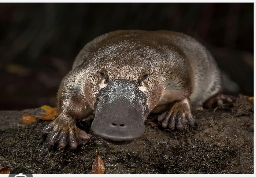The platypus

The platypus is a unique, semi-aquatic mammal found only in Australia. It's known for its duck-like bill, beaver-like tail, and otter-like feet. The platypus is one of the few venomous mammals, with males possessing a spur on their hind feet that delivers venom. Furthermore, the platypus is one of the only two mammals that lay eggs, along with the echidna.
Here's a more detailed look at the platypus:
Physical Characteristics:
Appearance:
The platypus has a sleek, furry body, a flat tail, and webbed feet, giving it a unique blend of features from various aquatic creatures.
Size:
Platypuses typically range from 15 to 24 inches in length, including their tail.
Bill:
Their bill is soft and sensitive, covered with thousands of receptors that help them detect prey underwater.
Venom:
Male platypuses have a venomous spur on their hind foot, which they use to fight during mating season.
Habitat and Behavior:
Location:
Platypuses inhabit freshwater rivers, lakes, and creeks in eastern Australia, including Tasmania.
Lifestyle:
They are mostly active at night and during dusk, spending much of their time underwater hunting for food.
Diet:
Platypuses are carnivores, feeding on insects, larvae, shellfish, and worms, which they gather from the bottom of the water with their bill.
Reproduction:
Egg-laying: Platypuses are one of the few mammals that lay eggs, with females typically producing one or two eggs per clutch.
Incubation: The female platypus keeps the eggs warm by holding them between her body and tail until they hatch.
Puggles: Baby platypuses are often called puggles.

- Art
- Causes
- Crafts
- Dance
- Drinks
- Film
- Fitness
- Food
- Spellen
- Gardening
- Health
- Home
- Literature
- Music
- Networking
- Other
- Party
- Religion
- Shopping
- Sports
- Theater
- Wellness


